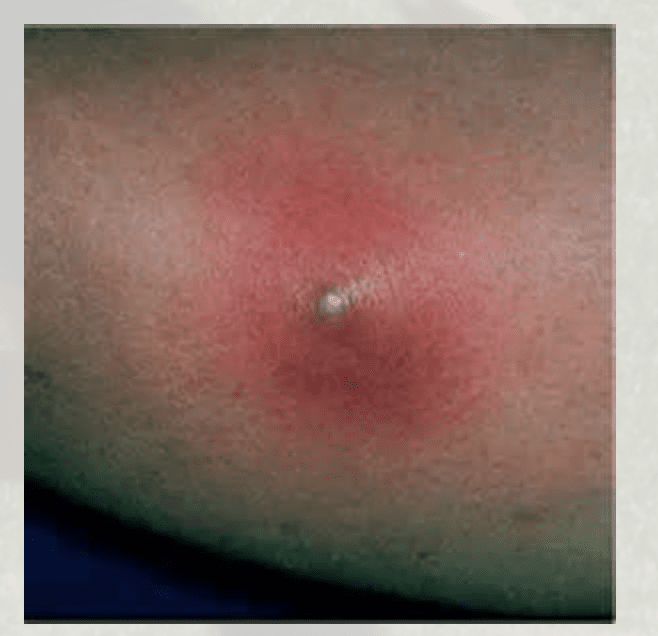On a fairly frequent basis, I will see patients who say “I think I have spider bites”.
I tend to be greeted by something like this raised “angry” appearing area.
It usually has a raised central yellow component surrounded by a red, tense outer rim.
Immediately, I’m thinking of something other than a spider bite.
When something looks like a spider bite, think something else.
The first thought should be a potentially devastating infection known as Methicillin-Resistant Staph Aureus or MRSA for short.
I’m not trying to minimize spiders and the potentially harmful impact of their bites. However, MRSA infections have become much, much more common and just as frightening.
We all have bacteria that grow on our skin. Most of them are fairly decent organisms that do little to interrupt daily activities.
However, certain bacteria that live on the skin surface are more ruthless.
Overtime they have gained an ability to cause deeper infections.
By developing resistance to many antibiotics, some bacteria may not always respond to usual medical treatments.
MRSA infections are just those type of worrisome beasts.
And yes, they look “just like spider bites.”
How do these spider bite look-a-likes get started?
Take a simple small scratch or other break in the skin. Any bacteria, including MRSA, can get involved in the wound. If left unchecked, MRSA infections can explode into limb and even life-threatening conditions. Wounds that are open can readily spread MRSA to others.
Contact and collision activities (such as wrestling or football) tend to have higher outbreak rates.
However, do realize that any exposed skin can be at risk.
Caught early in the course, there is ultimately less chance for more complicated outcomes.
Some individuals or even families, for reasons not fully understood, can get recurrent MRSA infections.
How can we prevent MRSA (aka spider bites)?
- Frequent self skin checks looking for open wounds, raised “angry” areas, or other abnormal skin conditions. Anything that looks sketchy should receive immediate medical attention
- Remove any individual with skin problems (especially “spider bites”) from group activities. Do not allow return until appropriate medical treatment and clearance
- Wear protective devices such as gloves and eye/mouth shields when working with potential or known MRSA infection
- Remove gear and clothing right after exercise followed by an immediate shower
- Wash clothing daily in hot water and/or use clean sets of clothing for each practice or game
- Studies have shown that sharing of items can increase spreading MRSA or other skin infections
- Require individual towels, wash clothes, hairbrushes, nail clippers, soaps, and other personal grooming products
- Frequently clean playing surfaces, equipment, tables and/or benches with appropriate anti-bacterial products
Treating spider bites and other raised wounds
When I see suspicious wounds, if possible, I try to open them up to release yellow “pus” material.
Called “incision and drainage”, this otherwise gross procedure serves two very important purposes:
- The mere act of opening the wound and allowing drainage can get rid of the infection
- Important to send drained fluid to the lab for culture. This can identify the offending bacteria and what best choice of antibiotic(s) may be used if needed in treatment
We think that relative overuse of antibiotics in the past helped create these more resistant bacteria. Thus, in certain cases, wound drainage alone (without antibiotic use) is a sensible treatment option.
With deeper infections (muscles, joints, or bones) or where drainage can’t be done or is ineffective, antibiotics may be prescribed.
Oral antibiotics are generally first-line for more skin-surface infections.
Deeper or more complicated infections might require hospitalization for intra-venous antibiotics or more aggressive surgical care.
Return to play after MRSA
After starting treatment for MRSA infection, the following minimal conditions must be met before return to contact or collision activities:
- Any drainage must have ended for at least 24-48 hours
- No new outbreaks or areas of infection
- If antibiotics started, must have minimum of 72 hour coverage
- Cover the infected areas with appropriate “occlusive”dressings to reduce risk of spread
ANY suspicion of MRSA infection requires immediate medical attention.
So, be appropriately afraid of those “spider bites”…..


